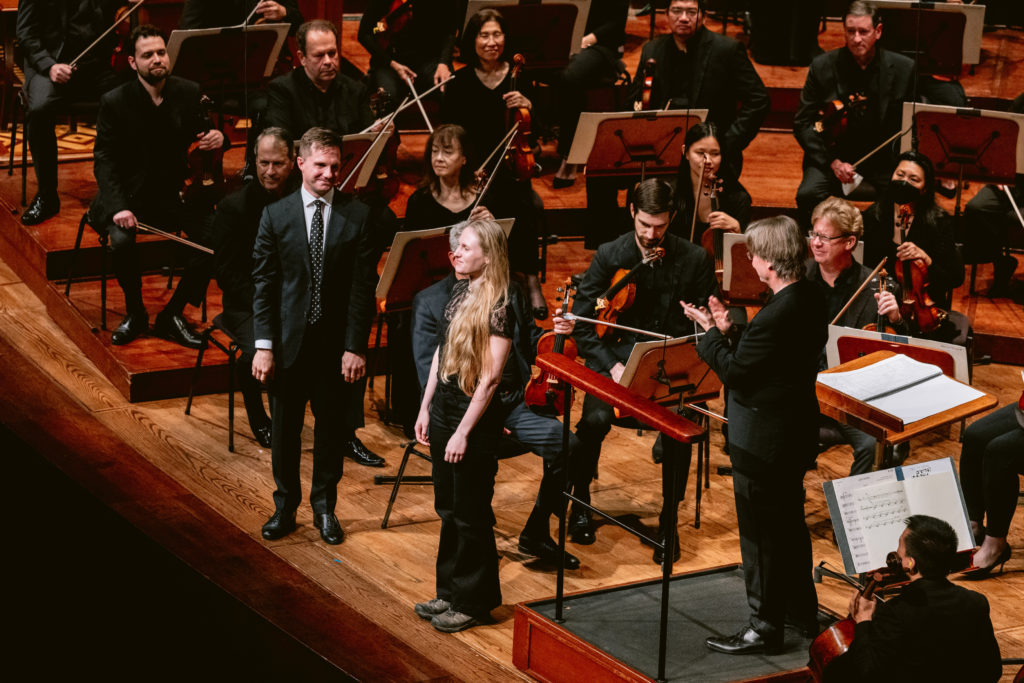San Francisco Symphony Offers Gabriella Smith’s Impressive ‘Breathing Forests’ to the California Festival
As part of its participation in the California Festival, the San Francisco Symphony under Music Director Esa-Pekka Salonen presented a concert titled From the Edge Friday in Davies Symphony Hall. The focus of the California Festival is new music, and Salonen’s program clearly filled the bill: Gabriella Smith’s 2021 Breathing Forests, a three-movement organ symphony; Steven Stucky’s 2005 orchestration of Igor Stravinsky’s ballet Les Noces from 1917, and Stravinsky’s Octet for Wind Instruments from 1923 in the composer’s own 1952 revision.
Bay Area composer Smith wrote Breathing Forests for the Los Angeles Philharmonic, where it was premiered in 2022 under Salonen’s direction with James McVinnie as the organ soloist. In her program notes delivered at Davies Symphony Hall, Smith explained how her environmental convictions prompted Breathing Forests. Although Smith consulted with McVinnie on the role of the organ in her piece, it is not actually an organ concerto. From the time of Handel, an organ concerto has been defined by the organ’s extensive solo thematic development set in dialogue with the orchestra. While Smith uses the organ throughout Breathing Forests, its flourishes are integrated into the orchestra’s overall texture more in the style of Camille Saint-Saëns’ Symphony No. 3, known as his Organ Symphony.As Smith’s first movement “Grow” opens, ostinatos from the organ’s highest range float over crackling string sounds. We hear chirping solos from the flute section and brass fanfares as she gradually expands the texture into a grand full orchestral climax supported by the low growl of the organ’s powerful pedal division.
Low-pitched, quiet motifs weave through the middle movement “Breathe,” and over sustained chords the horn section offers a wistful theme that brought to mind the whale calls in Alan Hovhaness’ 1970 And God Created Great Whales. Smith slowly builds to a roaring crescendo for both organ and orchestra undergirded by the stentorian reeds in the organ’s pedal division. She pulls back quickly from this mighty sound, allowing the horns to simulate a gentle breeze by blowing air through their instruments without creating pitched sounds.
Although the final movement is titled “Fire,” the conflagration that the strings vigorously simulate does not suggest catastrophic destruction, but rather nature’s thinning the stock so that fresh new growth will emerge. Smith creates hopeful, majestic waves of sound that crest on the orchestra’s robust bass sections and the organ’s comforting roar.
Salonen’s meticulous conducting brought laudable clarity and well-focused drive from the San Francisco Symphony, and McVinnie’s confident organ technique elegantly complemented the orchestra. The Davies Symphony Hall audience gave this new work its fervent approval.
In written reflections made long after the composition of his unusual choral ballet Les Noces, Stravinsky mused that he had once thought of scoring the work for large orchestra rather than the atypical four pianos and percussion he chose in 1917. Based on this observation, in 2005 the American composer Steven Stucky created a full orchestra score from the four piano score. Salonen and the orchestra, along with vocal soloists Lauren Snouffer, Kayleigh Decker, Paul Appleby, David Soar, and the San Francisco Symphony Chorus performed Stucky’s massive arrangement Friday. The sonic result proved impressive, sometimes verging on oppressive, and reminded me of Carl Orff’s grand mid-century oratorios–but on steroids.
The San Francisco Symphony performed this concert on November 17 & 18, 2023, in Davies Symphony Hall in downtown San Francisco. The November 17 concert was attended for this review.

Ken Herman, a classically trained pianist and organist, has covered music for the San Diego Union, the Los Angeles Times’ San Diego Edition, and for sandiego.com. He has won numerous awards, including first place for Live Performance and Opera Reviews in the 2017, the 2018, and the 2019 Excellence in Journalism Awards competition held by the San Diego Press Club. A Chicago native, he came to San Diego to pursue a graduate degree and stayed.Read more…


Thank you so much for the detailed, evocative description. Hope to hear it, one day.